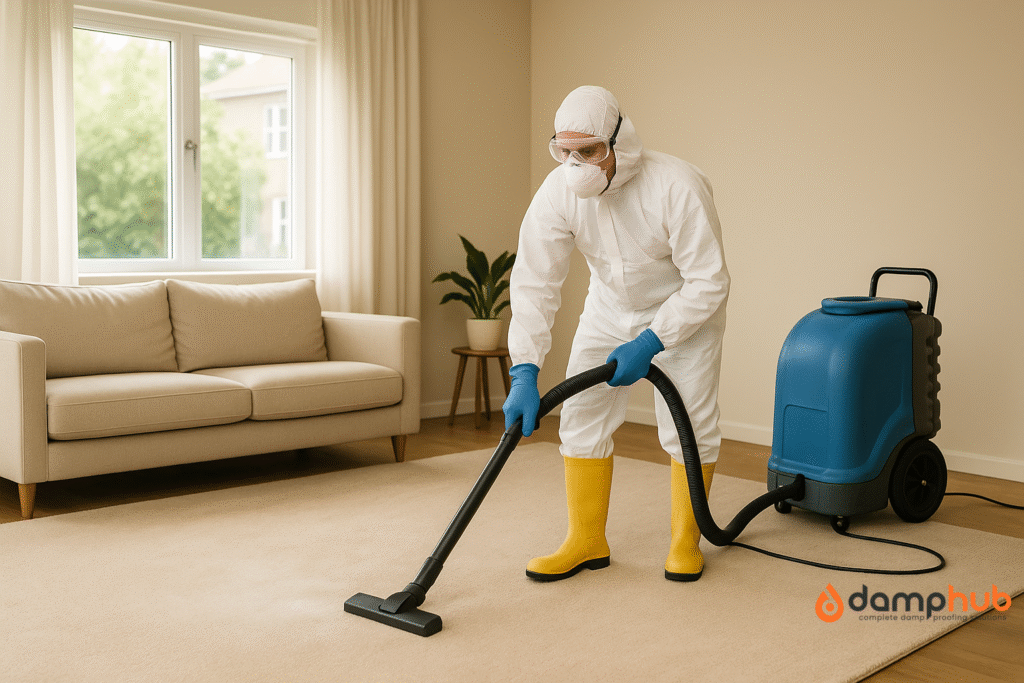
Quick Takeaways
- ✓ Carpet beetle bites are skin reactions, not real bites.
- ✓ Wash all clothes, bedding, and soft furnishings at 60°C.
- ✓ Vacuum regularly — especially edges, corners, and wardrobes.
- ✓ Use sealed storage, not cardboard boxes, for clothes and linens.
- ✓ Check second-hand items and loft spaces for signs of larvae.
If you’ve noticed a carpet beetle infestation and are waking up with bites or getting itchy after wearing stored clothes. In that case, you need to act quickly before the irritation worsens or the infestation spreads further.
But here is one quick thing you need to know — carpet beetles do not bite you like you’d assume or like bed bugs do. Rather, what you feel like carpet beetle bites is an allergic reaction to the tiny hairs shed by their larvae, which can irritate the skin and cause red, itchy spots.
In this guide, you’ll learn how to prevent these reactions, eliminate the source, and protect your home from further infestations.
Please make sure you also read 👉 How to Treat Carpet Beetle Rash
What Is a Carpet Beetle Bite?
As aforementioned, carpet beetles don’t sink their teeth into you. What most people call “carpet beetle bites” are skin reactions to the bristly hairs shed by the larvae.
As they move across carpets, bedding, and clothes, these larvae leave behind microscopic hairs that can irritate skin, especially in sensitive people.
You may notice:
- Red, itchy patches or welts
- A rash that appears overnight
- Localised bumps that look like insect bites
- Itching that flares up in bed or after wearing certain clothes
Good to Know:
If you’re getting repeated irritation in the same spot — like your arms, neck, or waistline — the problem could be in your clothes or bedding. Carpet beetle larvae hairs often cling to fabric. When that fabric presses against your skin, it can trigger reactions. Swapping or washing those items could stop the irritation fast.
Why Carpet Beetles Cause Skin Problems
It’s all about their larvae. While adult carpet beetles are harmless and more interested in flowers and windowsills, the larvae are drawn to natural fibres and quiet corners.
They feed on:
- Wool, silk, cotton, leather
- Pet fur, feathers, lint
- Stored clothing and bedding
- Upholstery, rugs, and even old taxidermy
As they feed and grow, they shed hairs — almost like fine splinters — that embed into fabric. When these come into contact with your skin, your body may treat them like an invader. Cue the itching, redness, and rashes people mistake for carpet beetle bites.

Pro Tip:
If you’re reacting but can’t find bed bugs or fleas, check wardrobes, cupboards, and carpet edges. You’re looking for small, striped, fuzzy larvae tucked into seams or fabric folds.
Please make sure you also read 👉 How to Identify and Get Rid of Carpet Beetle Larvae?
How Carpet Beetles Get Into Your Home
They don’t crash through the door. Carpet beetles get in quietly, and often ride in on something else. A bunch of flowers. A wool coat from the charity shop. A dusty box from the loft.
Common ways they enter:
- Open windows without insect screens
- Cut flowers or plants from outdoors
- Second-hand clothing, furniture, or rugs
- Stored belongings brought down from the attic or garage
- Bird nests or insect remains in lofts, vents, or chimneys
Once they’re inside, they look for dark, undisturbed spaces. If you’ve got a quiet corner full of jumpers, scarves, or pet fur, they’ve found the perfect spot to settle and lay eggs.
How to Get Rid of Carpet Beetle Bites and Prevent More
You’re not just treating the rash — you’re dealing with the cause. To stop carpet beetle bite symptoms, you have to remove the larvae, their hairs, and their food sources. That takes a proper clean, not just a surface tidy.
1. Deep Clean All Fabric Areas
Start with your Hoover — and don’t cut corners.
Vacuum:
- Along skirting boards and carpet edges
- Under beds and sofas
- Inside wardrobes, drawers, and cupboards
- Around light fittings, curtains, and vents
- Loft spaces and under-stair storage
Use the crevice tool. Empty the vacuum outside every time — larvae can survive inside the bag.

Good to Know:
A vacuum with a HEPA filter is best. It captures the fine larval hairs that trigger skin reactions and stops them from being blown back out.
Read more from us 👉 What Is a Varied Carpet Beetle?
2. Wash Bedding, Clothes, and Upholstery
Any soft fabric you’ve touched or worn could carry larvae or their hairs.
- Wash all bed linen on a hot cycle (60°C+)
- Freeze delicate items for 72 hours before washing gently
- Clean blankets, cushion covers, throws, and curtains
- Don’t forget dressing gowns, scarves, or pet beds
If you haven’t worn it in a while, wash it.
Pro Tip:
Always wash or freeze second-hand clothes before wearing them. Even items that look clean could be hiding carpet beetle larvae or hairs.
3. Store Clothes in Airtight Containers
Cardboard boxes and open baskets are practically an invitation.
Switch to:
- Sealed plastic storage boxes
- Vacuum-sealed bags for seasonal clothing
- Cedarwood blocks or lavender sachets in drawers
- Regular wardrobe checks, especially in humid months
Never store worn clothes, even once-worn ones — body oils and skin flakes are enough to attract larvae.
4. Seal Cracks and Entry Points
Don’t give them a way back in.
- Seal cracks in the flooring and skirting
- Add mesh to air bricks and vents
- Fit fly screens to windows
- Sweep out chimneys and clear old nests from roof spaces
If you’ve had an infestation in the loft or under floorboards, this step is essential.
How to Treat Carpet Beetle Skin Reaction?
If you’re dealing with itchy skin, red bumps, or a rash, there are a few simple ways to get relief:
- Wash the irritated area gently with warm water and mild soap
- Apply calamine lotion or a mild hydrocortisone cream to reduce itching
- Take an over-the-counter antihistamine if the reaction is strong
- Avoid scratching to prevent further irritation or infection
- Wear loose, clean clothes to let your skin heal
If it keeps coming back or spreads beyond the original area, speak to your GP. Some people develop more serious reactions with continued exposure.
Also, read 👉 Carpet Beetle Larvae vs Bed Bug: How to Spot the Difference

When to Call Pest Control
You’ve hoovered every corner. Washed everything. Sealed every gap. And still, you’re itching, and the larvae keep appearing.
That’s the point of calling in professionals.
- They can inspect insulation, lofts, and vents
- Use treatments that reach where DIY can’t
- Spot infestation signs you may have missed
Good to Know:
Even after cleaning, larval hairs can linger in mattresses, upholstery, or air ducts. If reactions persist, it may be time to go deeper.
Must read 👉 How to Identify and Get Rid of Carpet Beetle Larvae?
Final Word on Carpet Beetle Bite
A carpet beetle bite isn’t really a bite, but that doesn’t matter when you’re scratching at 2 a.m. It’s an allergic reaction to something you can’t see, but definitely feel.
The good news? You can get rid of it. Clean smart. Wash thoroughly. Store clothing the right way. And block off every route back in. If it’s too much to tackle alone, bring in someone who knows where they hide.
It’s your house. Not theirs.
Quick Recaps
- ✓ Carpet beetle larvae leave behind hairs that irritate your skin — not fangs.
- ✓ If you’re still itching after a full clean, those hairs are still around.
- ✓ You can clear a mild infestation yourself — but act quickly.
- ✓ Protect your fabrics now to avoid another outbreak later.
- ✓ Still reacting? It might be time to call in a pest professional.
Carpet Beetle Bite Question Answered

-
How to Stop Itching from Carpet Beetles?
Start by deep cleaning. Vacuum carpets, furniture, mattresses — anywhere fibres collect.
Then wash bedding, clothes, and curtains at 60°C if you can. You’re reacting to the larvae’s hairs, not a bite.
To ease the itching:
– Use a cold compress or take a lukewarm shower.
– Dab on calamine lotion or a mild antihistamine cream.
– Avoid scratching — it just makes it worse.Pro Tip: If the itching keeps coming back, there’s probably still beetle larvae in the home. Treat the source, not just the symptoms.
Read more guides from us: How to Get Rid of Carpet Beetles in the UK
-
What does a rash from carpet beetles look like?
It usually appears as small, red, itchy bumps — sometimes in lines or patches.
There’s no bite mark, just irritated skin. The rash can look a bit like heat rash or hives, and it’s most common on areas that come into contact with bedding or clothing.
You’re not being bitten — it’s an allergic reaction to the spiky little hairs that larvae shed as they crawl.
-
What are the symptoms of the beetle virus?
There is no beetle virus. Carpet beetles don’t spread any kind of virus or disease to humans. What you might experience are allergy-like symptoms caused by the larvae’s hairs, such as:
– Itchy skin
– Rash or redness
– Sneezing or watery eyes if the airs go airborneGood to Know: If someone mentions a “beetle virus,” they’re likely confused. The real issue is irritation, not infection.
-
What is the disease from beetle bites?
Carpet beetles don’t bite, so they don’t transmit any disease. The skin irritation people get comes from touching infested fabrics or surfaces — it’s an allergic reaction, not an illness.
If you’re seeing signs of infection (like swelling or pus), it’s probably from scratching or something unrelated. In that case, best to get it checked.
-
How long does a carpet beetle reaction last?
Most mild reactions settle within a few days, especially if you clean the home and stop further exposure. But in sensitive people, the itching or rash can hang around for a week or more.
If it lasts longer than that — or keeps flaring up — it’s a sign there’s still larvae or shed hairs in your bedding or furniture.
Try This: Keep hoovering every few days, wash soft furnishings, and take photos of any new skin changes in case it’s not the beetles.
-
Why are some people allergic to carpet beetles?
It’s down to the hairs. Carpet beetle larvae are covered in bristles that can irritate the skin, eyes, or lungs. If someone’s immune system is sensitive to those hairs, they’ll react — others might not notice a thing.
Some people just have stronger allergic responses. That’s why two people in the same house might have totally different symptoms.
-
Should I be worried if a beetle bites me?
Carpet beetles don’t bite, so if something’s nipped you, it was another insect. Fleas, mites, or bed bugs are far more likely.
That said, if you’ve got beetle larvae crawling around and their hairs are irritating your skin, it can feel a lot like a bite, even though it isn’t.
Pro Tip: Don’t assume. Try to catch or photograph the insect next time — proper ID is half the battle.
-
Are carpet beetles harmful to humans?
Not dangerously — but they’re still a pain. They don’t bite or carry disease, but they can cause:
– Itchy allergic reactions
– Skin rashes
– Aggravated asthma or breathing issues in sensitive peopleThey’re more of a nuisance than a threat. But if left untreated, they’ll damage your clothes and make your home uncomfortable fast.






